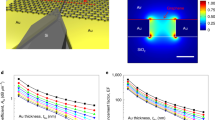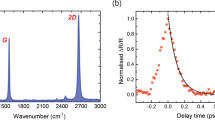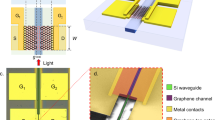Abstract
Optical-to-electrical conversion in graphene is a central phenomenon for realizing anticipated ultrafast and low-power-consumption information technologies. However, revealing its mechanism and intrinsic timescale require uncharted terahertz electronics and device architectures. Here we succeeded in resolving optical-to-electrical conversion processes in high-quality graphene via the on-chip electrical readout of an ultrafast photothermoelectric current. By suppressing the time constant of a resistor–capacitor circuit using a resistive zinc oxide top gate, we constructed a gate-tunable graphene photodetector with a bandwidth of up to 220 GHz. Measuring the non-local photocurrent dynamics, we found that the photocurrent extraction from the electrode is quasi-instantaneous without a measurable carrier transit time across several-micrometre-long graphene, following the Shockley–Ramo theorem. The time for photocurrent generation is exceptionally tunable from immediate to >4 ps, and its origin is identified as Fermi-level-dependent intraband carrier–carrier scattering. Our results bridge the gap between ultrafast optical science and device engineering, accelerating ultrafast graphene optoelectronic applications.
This is a preview of subscription content, access via your institution
Access options
Access Nature and 54 other Nature Portfolio journals
Get Nature+, our best-value online-access subscription
$29.99 / 30 days
cancel any time
Subscribe to this journal
Receive 12 print issues and online access
$209.00 per year
only $17.42 per issue
Buy this article
- Purchase on Springer Link
- Instant access to full article PDF
Prices may be subject to local taxes which are calculated during checkout




Similar content being viewed by others
Data availability
The datasets generated and/or analysed during the current study are available from the corresponding author upon reasonable request.
References
Cheng, Q., Bahadori, M., Glick, M., Rumley, S. & Bergman, K. Recent advances in optical technologies for data centers: a review. Optica 5, 1354–1370 (2018).
Romagnoli, M. et al. Graphene-based integrated photonics for next-generation datacom and telecom. Nat. Rev. Mater. 3, 392–414 (2018).
Song, J. C. W., Rudner, M. S., Marcus, C. M. & Levitov, L. S. Hot carrier transport and photocurrent response in graphene. Nano Lett. 11, 4688–4692 (2011).
Gabor, N. M. et al. Hot carrier-assisted intrinsic photoresponse in graphene. Science 334, 648–652 (2011).
Shiue, R. J. et al. High-responsivity graphene–boron nitride photodetector and autocorrelator in a silicon photonic integrated circuit. Nano Lett. 15, 7288–7293 (2015).
Muench, J. E. et al. Waveguide-integrated, plasmonic enhanced graphene photodetectors. Nano Lett. 19, 7632–7644 (2019).
Marconi, S. et al. Photo thermal effect graphene detector featuring 105 Gbit s−1 NRZ and 120 Gbit s−1 PAM4 direct detection. Nat. Commun. 12, 806 (2021).
Koppens, F. H. L. et al. Photodetectors based on graphene, other two-dimensional materials and hybrid systems. Nat. Nanotechnol. 9, 780–793 (2014).
Massicotte, M., Soavi, G., Principi, A. & Tielrooij, K.-J. Hot carriers in graphene—fundamentals and applications. Nanoscale 13, 8376–8411 (2021).
Tielrooij, K. J. et al. Photoexcitation cascade and multiple hot-carrier generation in graphene. Nat. Phys. 9, 248–252 (2013).
Song, J. C. W., Tielrooij, K. J., Koppens, F. H. L. & Levitov, L. S. Photoexcited carrier dynamics and impact-excitation cascade in graphene. Phys. Rev. B 87, 155429 (2013).
Urich, A., Unterrainer, K. & Mueller, T. Intrinsic response time of graphene photodetectors. Nano Lett. 11, 2804–2808 (2011).
Sun, D. et al. Ultrafast hot-carrier-dominated photocurrent in graphene. Nat. Nanotechnol. 7, 114–118 (2012).
Graham, M. W., Shi, S.-F., Ralph, D. C., Park, J. & McEuen, P. L. Photocurrent measurements of supercollision cooling in graphene. Nat. Phys. 9, 103–108 (2013).
Tielrooij, K. J. et al. Generation of photovoltage in graphene on a femtosecond timescale through efficient carrier heating. Nat. Nanotechnol. 10, 437–443 (2015).
Tielrooij, K. J. et al. Hot-carrier photocurrent effects at graphene–metal interfaces. J. Phys. Condens. Matter 27, 164207 (2015).
Tielrooij, K. J. et al. Out-of-plane heat transfer in van der Waals stacks through electron–hyperbolic phonon coupling. Nat. Nanotechnol. 13, 41–46 (2018).
George, P. A. et al. Ultrafast optical-pump terahertz-probe spectroscopy of the carrier relaxation and recombination dynamics in epitaxial graphene. Nano Lett. 8, 4248–4251 (2008).
Mics, Z. et al. Thermodynamic picture of ultrafast charge transport in graphene. Nat. Commun. 6, 7655 (2015).
Mihnev, M. T. et al. Microscopic origins of the terahertz carrier relaxation and cooling dynamics in graphene. Nat. Commun. 7, 11617 (2016).
Tomadin, A. et al. The ultrafast dynamics and conductivity of photoexcited graphene at different Fermi energies. Sci. Adv. 4, eaar5313 (2018).
Brida, D. et al. Ultrafast collinear scattering and carrier multiplication in graphene. Nat. Commun. 4, 1987 (2013).
Pogna, E. A. A. et al. Hot-carrier cooling in high-quality graphene is intrinsically limited by optical phonons. ACS Nano. 15, 11285–11295 (2021).
Rohde, G. et al. Ultrafast formation of a Fermi–Dirac distributed electron gas. Phys. Rev. Lett. 121, 256401 (2018).
Xia, F., Mueller, T., Lin, Y.-M., Valdes-Garcia, A. & Avouris, P. Ultrafast graphene photodetector. Nat. Nanotechnol. 4, 839–843 (2009).
McIver, J. W. et al. Light-induced anomalous Hall effect in graphene. Nat. Phys. 16, 38–41 (2020).
Auston, D. H. Picosecond optoelectronic switching and gating in silicon. Appl. Phys. Lett. 26, 101–103 (1975).
Prechtel, L. et al. Time-resolved ultrafast photocurrents and terahertz generation in freely suspended graphene. Nat. Commun. 3, 646 (2012).
Hunter, N. et al. On-chip picosecond pulse detection and generation using graphene photoconductive switches. Nano Lett. 15, 1591–1596 (2015).
Brenneis, A. et al. THz-circuits driven by photo-thermoelectric, gate-tunable graphene-junctions. Sci. Rep. 6, 35654 (2016).
Karnetzky, C. et al. Towards femtosecond on-chip electronics based on plasmonic hot electron nano-emitters. Nat. Commun. 9, 2471 (2018).
Yoshioka, K., Kumada, N., Muraki, K. & Hashisaka, M. On-chip coherent frequency-domain THz spectroscopy for electrical transport. Appl. Phys. Lett. 117, 161103 (2020).
Gallagher, P. et al. Quantum-critical conductivity of the Dirac fluid in graphene. Science 364, 158–162 (2019).
Tu, N. H. et al. Active spatial control of terahertz plasmons in graphene. Commun. Mater. 1, 7 (2020).
Kumada, N. et al. Suppression of gate screening on edge magnetoplasmons by highly resistive ZnO gate. Phys. Rev. B 101, 205205 (2020).
Gao, Y., Tsang, H. K. & Shu, C. A silicon nitride waveguide-integrated chemical vapor deposited graphene photodetector with 38 GHz bandwidth. Nanoscale 10, 21851–21856 (2018).
Song, J. C. W. & Levitov, L. S. Shockley–Ramo theorem and long-range photocurrent response in gapless materials. Phys. Rev. B 90, 075415 (2014).
Ma, Q. et al. Giant intrinsic photoresponse in pristine graphene. Nat. Nanotechnol. 14, 145–150 (2019).
Song, J. C. W., Reizer, M. Y. & Levitov, L. S. Disorder-assisted electron-phonon scattering and cooling pathways in graphene. Phys. Rev. Lett. 109, 106602 (2012).
Massicotte, M. et al. Dissociation of two-dimensional excitons in monolayer WSe2. Nat. Commun. 9, 1633 (2018).
Ma, Q. et al. Tuning ultrafast electron thermalization pathways in a van der Waals heterostructure. Nat. Phys. 12, 455–460 (2016).
Massicotte, M. et al. Picosecond photoresponse in van der Waals heterostructures. Nat. Nanotechnol. 11, 42–46 (2016).
Wang, L. et al. One-dimensional electrical contact to a two-dimensional material. Science 342, 614–617 (2013).
Ju, L. et al. Photoinduced doping in heterostructures of graphene and boron nitride. Nat. Nanotechnol. 9, 348–352 (2014).
Zuev, Y. M., Chang, W. & Kim, P. Thermoelectric and magnetothermoelectric transport measurements of graphene. Phys. Rev. Lett. 102, 096807 (2009).
Meric, I. et al. Current saturation in zero-bandgap, top-gated graphene field-effect transistors. Nat. Nanotechnol. 3, 654–659 (2008).
Jensen, S. A. et al. Competing ultrafast energy relaxation pathways in photoexcited graphene. Nano Lett. 14, 5839–5845 (2014).
Duan, J. et al. High thermoelectricpower factor in graphene/hBN devices. Proc. Natl Acad. Sci. USA 113, 14272–14276 (2016).
Paul, K. K., Kim, J. & Lee, Y. H. Hot carrier photovoltaics in van der Waals heterostructures. Nat. Rev. Phys. 3, 178–192 (2021).
Chen, H. et al. Ultrafast formation of interlayer hot excitons in atomically thin MoS2/WS2 heterostructures. Nat. Commun. 7, 12512 (2016).
Akamatsu, T. et al. A van der Waals interface that creates in-plane polarization and a spontaneous photovoltaic effect. Science 372, 68–72 (2021).
Masubuchi, S. et al. Autonomous robotic searching and assembly of two-dimensional crystals to build van der Waals superlattices. Nat. Commun. 9, 1413 (2018).
Acknowledgements
We thank K. Sasaki and K. Nozaki for fruitful discussions and H. Murofushi for technical support. K.W. and T.T. acknowledge support from the Elemental Strategy Initiative conducted by the MEXT, Japan (grant number JPMXP0112101001) and JSPS KAKENHI (grant numbers 19H05790, 20H00354 and 21H05233).
Author information
Authors and Affiliations
Contributions
K.Y. and N.K. conceived the experiment. K.Y. designed and built the optical set-up, performed the measurements and analysed the data. K.Y. and N.K. designed the terahertz circuits with support from T.W. and M.H. The devices were fabricated by T.W. and N.K. The hBN material was contributed by K.W. and T.T. The paper was written by K.Y. and N.K., with input from all authors.
Corresponding author
Ethics declarations
Competing interests
The authors declare no competing interests.
Peer review
Peer review information
Nature Photonics thanks Alexander Holleitner and the other, anonymous, reviewer(s) for their contribution to the peer review of this work.
Additional information
Publisher’s note Springer Nature remains neutral with regard to jurisdictional claims in published maps and institutional affiliations.
Supplementary information
Supplementary Information
Supplementary Figs. 1–8, Sections 1–6 and Table 1.
Rights and permissions
Springer Nature or its licensor holds exclusive rights to this article under a publishing agreement with the author(s) or other rightsholder(s); author self-archiving of the accepted manuscript version of this article is solely governed by the terms of such publishing agreement and applicable law.
About this article
Cite this article
Yoshioka, K., Wakamura, T., Hashisaka, M. et al. Ultrafast intrinsic optical-to-electrical conversion dynamics in a graphene photodetector. Nat. Photon. 16, 718–723 (2022). https://doi.org/10.1038/s41566-022-01058-z
Received:
Accepted:
Published:
Issue Date:
DOI: https://doi.org/10.1038/s41566-022-01058-z
This article is cited by
-
Bandwidth tunability of graphene absorption enhancement by hybridization of delocalized surface plasmon polaritons and localized magnetic plasmons
Discover Nano (2024)
-
Light-driven nanoscale vectorial currents
Nature (2024)
-
Frequency-selective perovskite photodetector for anti-interference optical communications
Nature Communications (2024)
-
A robust 3D self-powered photoelectrochemical type photodetector based on ReS2 nanoflowers
Journal of Materials Science: Materials in Electronics (2023)
-
Multilayer SnS2/few-layer MoS2 heterojunctions with in-situ floating photogate toward high-performance photodetectors and optical imaging application
Science China Materials (2023)



